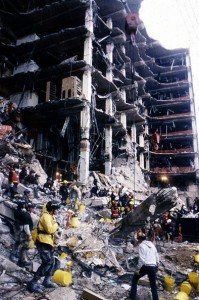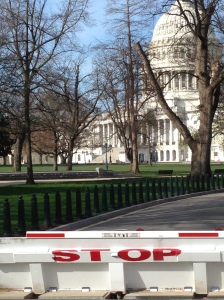Terror in the heartland: Oklahoma City, April 1995
The year 1995 was memorable for many reasons — including the frequency with which terrorism intruded.
In March 1995, members of a Japanese cult attacked the Tokyo subway system with Sarin gas, killing twelve people and sickening more than 5,000 others. In April, the elusive Unabomber struck for what would be the final time in his intermittent, 17-year letter-bombing spree. In September, the Washington Post and New York Times agreed jointly to publish the Unabomber’s so-called Manifesto, a diatribe against industrial society that provided clues leading to his capture the following year.
In early October 1995, the blind sheik, Omar Abdel Rahman, and nine other militant Muslims were convicted in federal court in New York City of plotting terror and assassinations across the city. Abdel Rahman was sentenced to life in prison. Meanwhile, a secret U.S. National Intelligence Estimate written in 1995 warned, presciently, that Islamist terrorism posed a cold-blooded threat to the country.
The deadliest and the most brazen act of terrorism in America in 1995 took place in Oklahoma City 20 years ago next week. There, in front of the Alfred P. Murrah federal building, a disgruntled U.S. Army veteran named Timothy McVeigh set off a massive truck bomb made of ammonium nitrate and nitromethane racing fuel.
The attack occurred just after 9 a.m. on April 19, as the Murrah building was filling with federal workers and visitors pursuing routine business with the government. Without warning, the truck bomb went off in a roar heard or felt for miles. The concussion from the blast swept the streets nearby, destroying or damaging buildings and cars, and sending debris and shards of plate glass flying everywhere.
The Murrah building was devastated, its North face blasted and nearly gone. It looked as if some gigantic, diabolic force had reached down and scooped away much of the facade.
As I write in my latest book, 1995: The Year the Future Began, the bombing’s toll “was staggering and unprecedented for an act of domestic terror in the United States. Inside the stricken building, 163 people were killed, including federal agents, Secret Service personnel, and armed forces recruiters. Five other people were killed nearby. … The fatal victims ranged in age from three months to seventy-three years.
“They included nineteen children—fifteen of whom were at the America’s Kids day-care center on the Murrah Building’s second floor, the windows of which allowed a view of Northwest Fifth Street and the sidewalk cut-out” where McVeigh — who was executed for his crimes in 2001 — had parked the truck.
The shock of the attack was profound: It was one of the two “flashbulb moments” of 1995 — events so powerful that people for years afterward remembered where they were when they heard the news. (The other “flashbulb moment” came in October, when verdicts were announced in the O.J. Simpson murder trial.)
As the devastation of the bombing became clear, the question — “Why Oklahoma City?” — seemed to be asked everywhere. It was an unassuming place—a place where, the Daily Oklahoman newspaper said the day after the attack, “terrorists don’t venture. . . . Car bombs don’t kill children here.”
Oklahoma City has hardly languished in the intervening 20 years. It is today a vibrant yet modest place, a friendly town for which a visitor can quickly develop an affinity. The site of the bombing has been impressively transformed into an outdoor memorial — a soothing, well-manicured park that offers no immediate reminder of the cold-blooded McVeigh, nothing obvious that tells visitors where he parked the truck and walked away.
The centerpiece of the memorial is the Field of Empty Chairs: Where the Murrah Building once stood, 168 glass, bronze, and stone chairs are arrayed in rows that roughly correspond to the floors of the stricken building.
The chairs, I write in 1995, “project a solemn and dignified ambiance, offering mute testimony to absence and irrecoverable loss.”
The effects of the bombing radiated far beyond Oklahoma City. In important ways, they reverberate still.
The attack, I point out in 1995, “represented a turning point in domestic security and security precautions for Americans.” It helped “to mold and put in place a hypercautious, security-first mindset that encouraged the imposition of restrictions intended to thwart the prospect of terrorist attack, a prospect that often seemed vague, amorphous, or abstract.
“These restrictions became tighter and more obsessive over the years,” especially after the terrorist attacks of September 11, 2001.
Striking evidence of this emergent mindset came a month after the attacks, in Washington, D.C.
Before dawn on May 20, 1995, authorities began setting up concrete barriers to detour vehicular traffic from a two-block section of Pennsylvania Avenue nearest the White House.
“The closure was ordered unilaterally, without public debate and without prior notice,” I note in 1995. “It was justified under the Treasury Department’s broad mandate to protect the president and his family. Although the closure had been privately under consideration for weeks, it became inevitable following the bombing in Oklahoma City.”
The closure of two blocks of Pennsylvania Avenue signaled not only an embryonic security-first mindset; it marked the emergence of the capital as a bunker. Sections of several streets near the Capitol were closed to vehicular traffic in the summer of 1995. Concrete planters and Jersey barriers went up near other government buildings that were presumed to be potential targets of terrorists.
“An architecture of defensiveness became plainly visible in the capital,” I write in 1995, “and its trappings—the barriers and the steel gates—have lent a shabby look to the avenues in the heart of Washington.”
It’s shabbiness endures.
More from The 1995 blog:
- Media fail: A 1995 subtext that’s familiar today
- Clinton, his portrait, and the persistent shadow of scandal
- Talking Internet history, and 1995
- Recalling the quaint early struggles to describe the Web
- Illuminating the Web: Netscape’s IPO of August 1995
- How important was Netscape?
- Recalling the ‘coolness’ of the early Web
- Hype and hoopla in a watershed year: Launching Windows 95
- Part One: Highlights of ‘1995’ interview with Reason.com
- Part Two: Interview takes up scandal, and ’90s ‘zeitgeist’
- Rolling out 1995



Pingback: Media fail: The flawed early coverage of 1995 OKC bombing | The 1995 Blog
Pingback: Closing off Pennsylvania Ave.: 1995 and a psychology of fear | The 1995 Blog
Pingback: Bob Dole, Hollywood, and ‘the mainstreaming of deviancy,’ 1995 | The 1995 Blog
Pingback: Downed pilot eludes Serbs: When Americans took notice of Bosnia | The 1995 Blog
Pingback: 1995 as tipping point: Recalling Smith Corona’s bankruptcy | The 1995 Blog
Pingback: The 1995 massacre at Srebrenica and its effects on U.S. policy | The 1995 Blog
Pingback: Predator drone down — over Bosnia, 20 years ago | The 1995 Blog
Pingback: When war in Bosnia reached the beginning of its end | The 1995 Blog
Pingback: Defying critics to publish the Unabomber ‘Manifesto’ | The 1995 Blog
Pingback: When America stood still: The O.J. verdicts, 20 years on | The 1995 Blog
Pingback: DNA: The enduring legacy of the 1995 O.J. trial | The 1995 Blog
Pingback: A memorable ‘first’ in 1995: Discovering the exoplanet | The 1995 Blog
Pingback: Million Man March: Controversial rally in a watershed year | The 1995 Blog
Pingback: The UN at 50: Palaver, pomposity, and the newspaper ‘lead’ of the year, 1995 | The 1995 Blog
Pingback: Spoofing her majesty in the ‘Great Royal Phone Embarrassment’ of 1995 | The 1995 Blog
Pingback: Amid suspicion and disdain, Dayton peace talks on Bosnia opened 20 years ago | The 1995 Blog
Pingback: Downer doc: Richard Holbrooke recalled on HBO | The 1995 Blog
Pingback: Closing government sows scandal: When Clinton met Monica | The 1995 Blog
Pingback: Bosnian war ended at Dayton 20 years ago; U.S. ‘hubris bubble’ swelled soon after | The 1995 Blog
Pingback: Looking back at a watershed year: 1995 in blog posts | The 1995 Blog
Pingback: The crowded closing day of 1995 | The 1995 Blog
Pingback: The 1995 ‘Trial of the Century’ is back: But so what? | The 1995 Blog
Pingback: FX miniseries on 1995 O.J. case is crassly exploitative | The 1995 Blog
Pingback: Ballyhoo over FX series leads to outsize claims about ’90s O.J. murder case | The 1995 Blog
Pingback: Fascination with sideshow: O.J. miniseries mirrors the 1995 trial | The 1995 Blog
Pingback: Beyond 1995: Accounting for the pop culture allure of the O.J. case | The 1995 Blog
Pingback: ‘Everything O.J. is in the zeitgeist right now’ | The 1995 Blog
Pingback: ESPN’s documentary about O.J. Simpson: A dissenting view | The 1995 Blog
Pingback: When the U.S. stood still: Awaiting the O.J. verdicts, October 1995 | The 1995 Blog
Pingback: The mixed lessons of the Dayton accords, 21 years on | The 1995 Blog
Pingback: PBS doc on OKC bombing signals anew the significance of 1995 | The 1995 Blog
Pingback: PBS doc on OKC bombing pushes hard on vague, distant connections | The 1995 Blog
Pingback: Timeless lessons of the 1995 Oklahoma City bombing | The 1995 Blog
Pingback: Messaging, sequencing a puzzle as CNN launches ’90s series | The 1995 Blog
Pingback: CNN series gives kitchen-sink treatment to the ’90s | The 1995 Blog
Pingback: Narcissism on full display: O.J. Simpson’s quasi-confession is aired | The 1995 Blog
Pingback: ‘Othering’ and the 1995 OKC bombing: Wiping away McVeigh? | The 1995 Blog
Pingback: Rambling nostalgia: WETA’s ‘Washington in the ’90s’ documentary | The 1995 Blog
Pingback: Fat new Holbrooke biography sheds little fresh insight on 1995 Dayton peace accords | The 1995 Blog
Pingback: The 1995 Blog turns five: A look back at five top posts | The 1995 Blog
Pingback: Misportrayals and missing DNA: Closing observations about flawed O.J. miniseries | The 1995 Blog
Pingback: Recalling a senator’s ill-timed ’95 announcement for president | The 1995 Blog
Pingback: Recalling John Doe No. 2, phantom suspect of the 1995 OKC bombing | The 1995 Blog
Pingback: ‘Richard Jewell,’ pack journalism, and a cinematic disappointment | Media Myth Alert
Pingback: With us still: 1995, 25 years on | The 1995 Blog
Pingback: 25 years on: Remembering the OKC bombing — and how the media erred | The 1995 Blog
Pingback: Even in a pandemic, media myths play on | Media Myth Alert